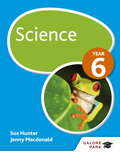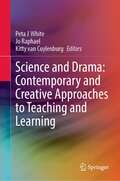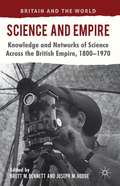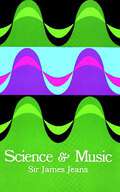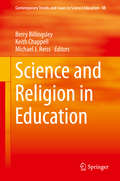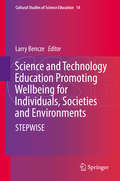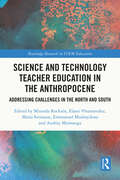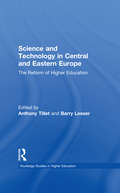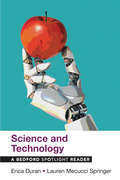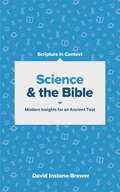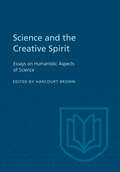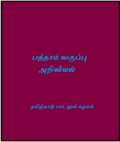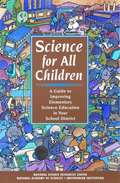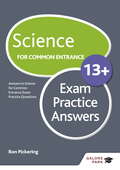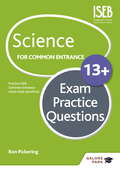- Table View
- List View
Science Year 6
by Jenny Macdonald Sue HunterExam Board: ISEBLevel: KS2Subject: ScienceFirst Teaching: September 2015First Exam: June 2017A stimulating and rigorous approach to Science that goes beyond the requirements of the National Curriculum for Year 6 pupils (aged 10 and above) preparing for Common Entrance and other independent entrance exams at 11+ o Endorsed by ISEB to ensure full coverage of the Common Entrance 11+ syllabuso Develop key skills with clear explanations and diagramso Explore scientific concepts with lots of practical activitieso Challenge understanding with varied exercises and extension questionsGalore Park Science Year 6 Answers available to purchase from the Galore Park website: www.galorepark.co.uk
Science Year 6 Answers
by Jenny Macdonald Sue HunterExam Board: ISEBLevel: KS2Subject: ScienceFirst Teaching: September 2015First Exam: Summer 2017Clear layout saves time marking work. Enables efficient assessment of pupils' strengths and weaknesses. Includes diagrams and working where necessary, to demonstrate how to present answers.
Science and Drama: Contemporary and Creative Approaches to Teaching and Learning
by Peta J White Jo Raphael Kitty Van CuylenburgThis edited volume presents interdisciplinary and transdisciplinary approaches to drama and science in education. Drawing on a solid basis of research, it offers theoretical backgrounds, showcases rich examples, and provides evidence of improved student learning and engagement. The chapters explore various connections between drama and science, including: students’ ability to engage with science through drama; dramatising STEM; mutuality and inter-relativity in drama and science; dramatic play-based outdoor activities; and creating embodied, aesthetic and affective learning experiences. The book illustrates how drama education draws upon contemporary issues and their complexity, intertwining with science education in promoting scientific literacy, creativity, and empathetic understandings needed to interpret and respond to the many challenges of our times. Findings throughout the book demonstrate how lessons learned from drama and science education can remain discrete yet when brought together, contribute to deeper, more engaged and transformative student learning.
Science and Empire
by Brett M. Bennett Joseph M. HodgeOffering one of the first analyses of how networks of science interacted within the British Empire during the past two centuries, this volume shows how the rise of formalized state networks of science in the mid nineteenth-century led to a constant tension between administrators and scientists.
Science and Environment Class 7-Nepal (English Language)
by Nepal Curriculum CenterThis accessible book has been developed by Action on Disability Rights And Development-Nepal (ADRAD) for the free distribution to students with visual and print disabilities in cooperation of Curriculum Development Center and Australian Embassy in Nepal under Direct Aid Program.
Science and Environment Grade 6-Nepal (English Language)
by Nepal Curriculum CenterThis accessible book has been developed by Action on Disability Rights And Development-Nepal (ADRAD) for the free distribution to students with visual and print disabilities in cooperation of Curriculum Development Center and Australian Embassy in Nepal under Direct Aid Program.
Science and ICT in the Primary School: A Creative Approach to Big Ideas
by John MeadowsWith a strong focus on helping children to learn the 'big ideas' in science, this book provides detailed and practical guidance on how to use ICT to support creative science teaching. Emphasizing learning science 'through' the technology rather than 'from' it, the book strikes a good balance between practical and academic dimensions through: practical suggestions on how to plan schemes of work and lessons case studies that highlight how ICT can be incorporated into cross-curricular themes of study examples of real science lessons advice on organizing learning in 'out of school' settings' Written with the standards for achieving qualified teacher status in mind, this user-friendly text is a vital resource for all students on initial teacher training courses and newly qualified teachers at primary level.
Science and Music (Dover Books On Music Ser.)
by James JeansSir James Jeans, noted British scientist, has given a physical analysis of musical sounds, in what is considered to be the best exposition on the subject, a book of great intellectual stature. His aim has been to convey precise information, in a simple non-technical way, that will be of interest to the amateur as well as the serious student of music. The discussion begins with an explanation of the development of the human faculty of hearing. It is established that each sound can be represented by a curve. An examination of the general properties of sound-curves follows. For example, why do some sounds produce pleasure when they reach our ears and some pain? How do we retain the pleasurable qualities in the sound-curve, as it passes on from one stage of electronic equipment to another? To what extent is it possible to prevent unpleasant qualities from contaminating the curve? These and other pertinent questions on the transmission and reproduction of sound-curves are answered in a discussion of tuning-forks and pure tones. The various methods of producing sound, and the qualities of the sounds produced, are further discussed as they relate to vibrations of strings and harmonics, and vibrations of air. Harmony and discord are also considered. In the final chapters on the concert room and hearing, the discussion focuses on the transmission of sound from its source to the eardrum and from the eardrum to the brain. A general theory of acoustics is also covered as well as acoustical analyses.
Science and Religion in Education (Contemporary Trends and Issues in Science Education #48)
by Michael J. Reiss Berry Billingsley Keith ChappellThis book brings together the latest research in education in relation to science and religion. Leading international scholars and practitioners provide vital insights into the underlying debates and present a range of practical approaches for teaching. Key themes include the origin of the universe, the theory of evolution, the nature of the human person, the nature of science and Artificial Intelligence. These are explored in a range of international contexts. The book provides a valuable resource for teachers, students and researchers in the fields of education, science, religious education and the growing specialist field of science and religion.Science and Religion in Education is a compelling read for current and future generations of academic researchers and teachers who wish to explore the fascinating intersect between science education and religious studies. The research findings and insights presented by these international scholars offer new dimensions on contemporary practice. - Vaille Dawson, Professor of Science Education, University of Western AustraliaScience and Religion in Education offers a fascinating and diverse collection of chapters surveying the current state of thinking about how science and religion can be understood in education. The book offers a wealth of thought-provoking material for anyone interested in the natures of science and religion, their relationship(s), or their representation within the curriculum. - Professor Keith Taber, University of CambridgeScience education and religious education are uncomfortable bedfellows. This book, written in part as a response to the – perhaps too clear – accounts of Ian Barbour, provides suitably nuanced pictures of how science and religion are dealt with in schools. Whatever the views of specialists, young people ‘receive’ an education in both science and religion: hearing their voices is refreshing in such a serious academic account. - Julian Stern, Professor of Education and Religion, York St John UniversityHumans have long endeavored to make sense of the world often using science and religion. Yet, these two great traditions are frequently seen as incompatible. This useful volume features thoughtful contributions from experts whose work straddles the divide and provides educators with arguments, engaging strategies and historical perspectives to help build a bridge and allow a fruitful discussion in schools. - William F. McComas, Distinguished Professor of Science Education, University of ArkansasEqual parts critical examination of existing models for the relationship between science and religion, scholarly exposition of newer models, and insights toward practical application in classrooms, this book is an invaluable resource for science and religion educators. If you have been thinking it is time we looked beyond Barbour’s taxonomy, you will want to read this book. If you have not, I implore you to read this book. - Jason Wiles, Associate Professor of Biology and Science Education, Syracuse University
Science and Sustainability
by University of California at Berkeley Lawrence Hall of ScienceScience and Sustainability is a different kind of science course. It not only covers many of the scientific concepts usually included in biology, chemistry, and physics classes, but also relates those concepts to issues of sustainability. Most likely, you have already explored many scientific concepts, but you may not be familiar with the term sustainability. Sustainability refers to the ability of populations of living organisms to continue, or sustain, a healthy existence in a healthy environment "forever."
Science and Technology
by Dimitris N. ChorafasThe aim of this book is to explore science and technology from the viewpoint of creating new knowledge, as opposed to the reinterpretation of existing knowledge in ever greater but uncertain detail. Scientists and technologists make progress by distinguishing between what they regard as meaningful and what they consider as secondary or unimportant. The meaningful is dynamic; typically, the less important is static. Science and technology have made a major contribution to the culture and to the standard of living of our society. From antiquity to the present day, the most distinguished scientists and technologists have been thinkers, experimenters and persons willing and able to challenge "the obvious". Technology develops products and processes based on the breakthroughs of science. If technologists fail to steadily upgrade their skills, tools and methods, they will only be as good as their last design, risking obsolescence. Using practical examples and case studies, this book documents the correlations existing between science and technology, and elucidates these correlations with practical applications ranging from real-life situations, from R&D to energy production. As it is a salient problem, and a most challenging one to our society, power production has been chosen as a major case study. The holistic approach to science and technology followed by this text enhances the ability to deliver practical results. This book is intended for students and researchers of science, technology and mathematical analysis, while also providing a valuable reference book for professionals. Its subject is one of the most debated problems of mankind.
Science and Technology Education Promoting Wellbeing for Individuals, Societies and Environments
by Larry BenczeThis edited volume provides theoretical and practical resources relating to the 'STEPWISE' curricular and instructional framework. 'STEPWISE' is the acronym for Science & Technology Education Promoting Wellbeing for Individuals, Societies & Environments. It is a framework for organizing teaching and learning domains in ways that prioritize personal and social actions to address 'critical socioscientific issues' -- that is, controversial decisions by powerful individuals/groups about science and technology (and related fields) that may adversely affect individuals, societies and/or environments. The book contains chapters written by and/or with teachers who have used STEPWISE to guide their instructional practices, as well as chapters written by education scholars who have used a range of theoretical lenses to analyze and evaluate STEPWISE -- and, in several cases, described ways in which it relates to (or could relate to) their practices and/or ways in which the framework might logically be amended. Overall, this book offers educators, policy makers and others with resources useful for arranging science and technology education in ways that may assist societies in addressing significant potential personal, social and/or environmental problems -- such as dramatic climate change, preventable human diseases, species losses, and social injustices -- associated with fields of science and technology.
Science and Technology Teacher Education in the Anthropocene: Addressing Challenges in the North and South (Routledge Research in STEM Education)
by Miranda RocksénThis unique book compares anthropogenic challenges in science and technology teacher education between the northern and southern contexts of Sweden and South Africa, respectively. Presenting the results of a three-year research collaboration between science and technology teacher education researchers from South Africa and Sweden, the book explores theoretical perspectives and pedagogical experiences in response to challenges in the Anthropocene. It discusses research-informed practice in teacher education to address sustainable development. Chapters in the book collectively investigate the influence of current environmental and societal changes on the education of teachers, answering the question of how science and technology teacher education can adjust to current changes in the world and prepare new teachers for work in their future profession. Touching on issues such as climate change, global warming and pandemic diseases, the book uses a comparative approach and explores opportunities and possibilities for fulfilling the goals of science and technology education for sustainable development. The book offers recommendations and opportunities to implement sustainability issues and develop sustainable teaching strategies. It will be a key reading for researchers, academics and post-graduate students in the fields of teacher education, science and technology education, sustainability education and comparative education.
Science and Technology in Central and Eastern Europe: The Reform of Higher Education (RoutledgeFalmer Studies in Higher Education #8)
by Anthony Tillet Barry LesserFirst Published in 1996. Routledge is an imprint of Taylor & Francis, an informa company.
Science and Technology: A Bedford Spotlight Reader
by Erica Duran Lauren Mecucci SpringerScience and Technology explores questions around the central concepts of STEM fields: How do we interact with science and technology on a daily basis? Is technology surpassing biology? What are the ethics of science and technology? Does technology rule our economy? How is the internet changing society? Readings by biologists, climate scientists, journalists, ethicists, novelists, engineers, and others take up these questions and more. Questions and assignments for each selection provide a range of activities for students. The Bedford Spotlight Reader Series is an exciting line of single-theme readers, each reflecting Bedford’s trademark care and quality. An editorial board of a dozen compositionists at schools with courses focusing on specific themes assists in the development of the series. Each reader collects thoughtfully chosen selections sufficient for an entire writing course—about 35 pieces—to allow instructors to provide carefully developed, high-quality instruction at an affordable price. Bedford Spotlight Readers are designed to help students from all majors make sustained inquiries from multiple perspectives, opening up topics such as borders, food, gender, happiness, humor, language, monsters, music, subcultures, and sustainability, to critical analysis. The readers are flexibly arranged in thematic chapters, with each chapter focusing in depth on a different facet of the central topic. The instructor resource tab of each reader’s catalog page includes instructor support with sample syllabi and additional teaching resources.
Science and the Bible: Modern Insights for an Ancient Text (Scripture in Context Series)
by David Instone-BrewerIs the Bible fundamentally at odds with science? Science and the Bible are often pitted against each other, causing many to either defend science at Scripture's expense, or vice versa. Instead, what if we saw them as friends? Can Christians appreciate scientific insights like they do archaeological discoveries--as a source of knowledge to illuminate the biblical world and our own? In Science a nd the Bible, David Instone-Brewer takes a refreshing and non-antagonistic approach, asking how science can aid our interpretation of the Bible. The result is stimulating on topics such as God's omnipresence, the origin of languages, the nature of eternity, the relationship of spirit and soul, the reality of resurrection, and Jesus' human experience. In short, readable chapters, Science and the Bible enables the curious layperson to reread the Bible with fresh perspectives from modern scientific insights. The Scripture in Context series is driven by the conviction that there is nothing as exciting, direct, provocative, and spiritually enlightening as the Bible when we read it as it was meant to be read. Each book in the series dives into the ancient cultural context behind Bible passages, examining the effect this context had on what the Bible writers were saying and how we should understand their words today. When we read the Bible in light of its context, it is anything but boring. Instead, God's word can speak to us as powerfully as it did to those who first read it.
Science and the Creative Spirit
by Harcourt BrownIn the world of today, men on both sides of the science-humanities barrier feel an urgent need for mutual understanding. This symposium sponsored by the American Council of Learned Societies, stressed that it is only in a spirit of disinterested yet sincere evaluation that science and humanism can escape disastrous consequences in the future. Karl W. Deutsch (M.I.T.) deals with the general area of interplay between the sciences and the non-scientific aspects of our culture. F.E.L. Priestley (University of Toronto) discusses the impact of science on English literature. David Hawkins (University of Colorado) surveys the anthropological background of science. Harcourt Brown (Brown University) gives an account of the influence of the scientific outlook in French literary culture, and contributes an introduction explaining how the book came to be written.
Science class 10 - Tamil Nadu Board - SCERT: அறிவியல் பத்தாம் வகுப்பு
by Scert Tamil Naduஇந்த அறிவியல் பாடத்தில் பலதரப்பட்ட விஞ்ஞான விஷயங்களும் மற்றும் தாவரங்கள் விலங்குகள் பற்றியும் நாம் தெரிந்து கொள்வதற்கு உதவியாக இருக்கிறது.
Science class 6 - RBSE Board: विज्ञान कक्षा 6 - आरबीएसई बोर्ड
by Rajasthan State Textbook BoardScience Textbook for Class 6, Education book
Science class 7 - RBSE Board: विज्ञान कक्षा 7 - आरबीएसई बोर्ड
by Rajasthan State Textbook BoardScience Textbook for Class 7, Education book
Science class 8 - RBSE Board: विज्ञान कक्षा 8 - आरबीएसई बोर्ड
by Rajasthan State Textbook BoardScience Textbook for Class 8, Education book
Science for All Children: A Guide to Improving Elementary Science Education in Your School District
by National Academy of Sciences Staff Smithsonian Institution StaffRemember the first time you planted a seed and watched it sprout? Or explored how a magnet attracted a nail? If these questions bring back memories of joy and wonder, then you understand the idea behind inquiry-based science--an approach to science education that challenges children to ask questions, solve problems, and develop scientific skills as well as gain knowledge. Inquiry-based science is based on research and experience, both of which confirm that children learn science best when they engage in hands-on science activities rather than read from a textbook.The recent National Science Education Standards prepared by the National Research Council call for a revolution in science education. They stress that the science taught must be based on active inquiry and that science should become a core activity in every grade, starting in kindergarten. This easy-to-read and practical book shows how to bring about the changes recommended in the standards. It provides guidelines for planning and implementing an inquiry-based science program in any school district.The book is divided into three parts. "Building a Foundation for Change," presents a rationale for inquiry-based science and describes how teaching through inquiry supports the way children naturally learn. It concludes with basic guidelines for planning a program.School administrators, teachers, and parents will be especially interested in the second part, "The Nuts and Bolts of Change." This section describes the five building blocks of an elementary science program: Community and administrative support. A developmentally appropriate curriculum. Opportunities for professional development. Materials support. Appropriate assessment tools. Together, these five elements provide a working model of how to implement hands-on science.The third part, "Inquiry-Centered Science in Practice," presents profiles of the successful inquiry-based science programs in districts nationwide. These profiles show how the principles of hands-on science can be adapted to different school settings.If you want to improve the way science is taught in the elementary schools in your community, Science for All Children is an indispensable resource.
Science for Common Entrance 13+ Exam Practice Answers (for the June 2022 exams)
by Ron PickeringPlease note, this resource is suitable for the exams up to June 2022. New revision resources will be available from Spring 2022 for the exams from November 2022.Exam Board: ISEBLevel: 13+Subject: ScienceFirst Teaching: September 2015First Exam: Autumn 2018Confidently mark answers to the Science for Common Entrance 13+ Exam Practice Questions with worked examples, exam advice and tips for achieving the best results- Helps pupils to refine answers with guidance and worked examples- Includes ISEB Common Entrance mark scheme and advice for achieving top marks- Suitable for all ISEB Science 13+ Common Entrance exams taken from Autumn 2017 onwardsAlso available to purchase from the Galore Park website www.galorepark.co.uk:- Science for Common Entrance 13+ Exam Practice Answers- Science for Common Entrance 13+ Exam Practice Questions- Science for Common Entrance 13+ Revision Guide- Science for Common Entrance: Biology- Science for Common Entrance: Biology Answers- Science for Common Entrance: Chemistry- Science for Common Entrance: Chemistry Answers- Science for Common Entrance: Physics- Science for Common Entrance: Physics Answers
Science for Common Entrance 13+ Exam Practice Questions (for the June 2022 exams)
by Ron PickeringPlease note, this resource is suitable for the exams up to June 2022. New revision resources will be available from Spring 2022 for the exams from November 2022.Exam Board: ISEBLevel: 13+Subject: ScienceFirst Teaching: September 2015First Exam: Autumn 2018Practise 13+ Science with this wealth of exam-style questions that have been designed to reflect the style and level of the ISEB Common Entrance Science exam. The range of questions helps pupils improve their exam technique and provides realistic practice for Biology, Chemistry and Physics exams at 13+.- Covers every 13+ topic for Biology, Chemistry and Physics- Familiarises pupils with the type of questions they will face in the exam- Identifies strengths and weaknesses using topic-based exercises- Suitable for ISEB 13+ Mathematics Common Entrance exams taken from Autumn 2017 onwardsAlso available to purchase from the Galore Park website www.galorepark.co.uk:- Science for Common Entrance 13+ Exam Practice Answers- Science for Common Entrance 13+ Revision Guide- Science for Common Entrance: Biology- Science for Common Entrance: Biology Answers- Science for Common Entrance: Chemistry- Science for Common Entrance: Chemistry Answers- Science for Common Entrance: Physics- Science for Common Entrance: Physics Answers
Science for Common Entrance 13+ Revision Guide (for the June 2022 exams)
by Richard BaldingPlease note, this resource is suitable for the exams up to June 2022. New revision resources will be available from Spring 2022 for the exams from November 2022.Exam Board: ISEBLevel: 13+Subject: ScienceFirst Teaching: September 2015First Exam: Autumn 2017Revise every topic and theory tested in the ISEB 13+ Common Entrance exams for Biology, Chemistry and Physics. This essential revision tool covers all the content of the new ISEB 13+ Common Entrance syllabus for Biology, Chemistry and Physics. The knowledge required for the exam is integrated with practical exam tips and advice to make revision easier and more effective.- Consolidates revision with all key information in one place- Ensures pupils have covered everything with the handy revision checklist- 'Test yourself' exercises identify areas requiring further study- Suitable for ISEB 13+ Science Common Entrance exams taken from Autumn 2017 onwardsAlso available to purchase from the Galore Park website www.galorepark.co.uk:- Science for Common Entrance 13+ Exam Practice Answers- Science for Common Entrance 13+ Exam Practice Questions- Science for Common Entrance: Biology- Science for Common Entrance: Biology Answers- Science for Common Entrance: Chemistry- Science for Common Entrance: Chemistry Answers- Science for Common Entrance: Physics- Science for Common Entrance: Physics Answers
